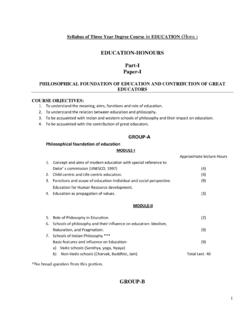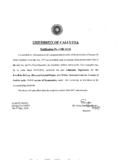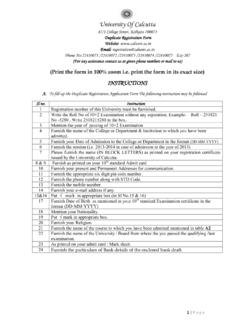Transcription of UNIVERSITY OF CALCUTTA
1 UNIVERSITY OF CALCUTTA SYLLABI F O R THREE-YEAR HONOURS & GENERAL DEGREE COURSES OF STUDIES HISTORY 2010 HONOURS COURSE OF STUDIES IN HISTORY Division of papers for the Undergraduate Honours course in History Part I 1. History of India from the earliest Times to 600 CE [Existing Paper I] 2. History of India from C 600 to C1500 [Existing Paper II] Part II 3. Transformation of Europe (15th 17th Centuries) [Existing Paper III] 4. History of India from C1500 to C1800 [Existing Paper V] Part III 5. ( Group A)History of East Asia from 1839 to 1950 OR (Group B)Aspects of Antiquity [Existing Paper IV] 6. History of India from C1800 to 1964 [Existing Paper II] 7. History of Europe from 1789 to 1919 [Existing Paper VII] 8. World Politics in the 20th Century from 1919 to C2000 [Existing Paper VIII] PART I PAPER-I History of India from the earliest Times to 600 CE UNIT-I (50 marks.)
2 40 lectures) Module-I Sources of Early Indian History Classification and importance of both Literary and Archaeological sources Understanding the nature of the sources for each period History and Itihasa Module-II Changing Relationship between people and landscape, from hunter-gatherers to post Harappan cultures in the Indian subcontinent The importance of understanding archaeological cultures viz a` viz landscape features- Hunter Gatherers to Early Pastoralists and Agriculturists An over view of archaeological cultures in the subcontinent- pre-Mehrgarh , Mehrgarh and contemporary to Mehrgarh Early/Pre Harappan Cultures Prelude to Harappan Civilization Harappan Civilization the First Urbanization Pastoralist/Early agriculturist Cultures contemporary to the Harappan-various Neolithic and Chalcolithic cultures of the Indian subcontinent Decline of the Harappan civilization-Late/Post Harappan Cultures- a) Cemetery H phase, b) Gandhara Grave phase, c) Lustrous Red Ware.
3 Module III The Vedic Corpus and transition to the age of Janapadas and Mahajanapadas ( BCE) Spread of settlements -Political situation Aryan Debate Archaeological cultures beyond the Vedic milieu Ochre coloured pottery, Black &Red Ware and Painted Grey Ware from chiefdom to kingdom- the Ganasangha tradition- sixteen mahajanapadas- Pre-eminence of Magadha Module-IV Mauryan & Post Mauryan India (c. 400 BCE-300CE) Nature and extent of the Mauryan empire Asoka s Dhamma Decline of the Empire - rise of regional power centres in the post Mauryan period. Central Asian intervention in north Indian politics focusing on the Indo-Greeks and the Kushanas The Satavahanas and their struggle with the Saka Kshatrapas of western India Kings and chieftains the Cheras, Cholas and Pandyas- Sangam literature and archaeological evidence. Module- V The Age of the Guptas ( 600CE) Historical situation of India in 300CE Emergence of the Gupta empire The Empire in its mature form Political achievements of the rulers disintegration of the empire Administrative structure of the empire with special reference to Bengal Notion of Classical age and Threshold times An introduction to the contemporary dynasties like the Vakatakas, the Kadambas etc.
4 , UNIT-II (50 marks; 40 lectures) Module-I Aspects of Society Beginning of the Varna hierarchy in the Vedic period forms of marriage position of women Varna and Jati property rights of women Slavery, Untouchability and attitude towards women Module-II Religious Development Vedic religion Changing notion of gods and goddesses-Sacrificial practices Rise of new religious groups & philosophical thoughts Buddhism, Jainism and philosophy of the Ajivikas and Charvakas Doctrinal and philosophical Changes in Buddhism and Jainism Rising Importance of the Brahmanical religion Different Brahmanical religious groups. Module III Comparative Structures of Economies in some early states-Maurya- Satavahana-Kushana-Gupta Introduction Agrarian economy Non agricultural production crafts guilds Monetization Land grants and its politico economic significance (Gupta period) Module-IV Patterns of Trade, Urbanization & Routes of communication Trade and Urban development-Second urbanization Trading networks both inland and maritime (with special reference to linkage with Roman Empire as well as Southeast Asian countries)
5 Merchants and Markets Module-V Cultural life Languages and Scripts An overview Nature of Mauryan art Presence of different schools of sculpture and terracotta art in the post Mauryan period Different kinds of Religious Architecture, Sculptural art and Painting an overview Systems of knowledge Science, Technology &Medicine Suggested Readings , The Wonder That Was India, London, 1954. Irfan Habib (general editor), A People s History of India (Relevant volumes), New Delhi. Vol. 1 Pre-history, Vol. 2 The Indus Civilisation, Vol. 3 The Vedic Age, , Ancient India: An Introduction, New Delhi, 1998. , An Introduction to the Study of Indian History, Bombay, 1956. ------------------ Combined Methods in Indology and Other Writings, Edited and Introduced by , 2007 (revised edition) (general editor), The History & Culture of the Indian People, volumes I-III, Bombay, 1951, 1968,1970 Shireen Ratnagar, Understanding Harappa, Delhi, 2001.
6 Nihar Ranjan Ray, Brajadulal Chattopadhyaya, Mani and Ranabir Chakravarti eds. A Source Book of Indian Civilization, Kolkata, 2000. Raychaudhuri, Political History of Ancient India with a commentary by , New Delhi, 1996 (8th edition) , India s Ancient Past, New Delhi, 2005. Upinder Singh. A History of Ancient and Early Medieval India. Delhi, 2008. Romila Thapar, Early India: From the Origins to AD 1300, London, 2002. Asvini Agarwal, The Rise and Fall of the Imperial Guptas, New Delhi, 1988. , The Archaeology of India, London, 1982. Allchin (ed). The Archaeology of Early Historic South Asia: The Emergence of Cities and States, Cambridge, 1995. , The Position of Women in Hindu Civilization from Pre-historic times to the Present Day, New Delhi, 1962. ed. A Cultural History of India, New Delhi, 1975. Sukumari Bhattacharji. Women and Society in Ancient India. CALCUTTA , 1994. Dilip Kumar Chakrabarti, India, An Archaeological History, Delhi, 1999 ------------------------------An Oxford Companion to Indian Archaeology, New Delhi, 2006.
7 Uma Chakravarti. The Social Dimensions of Buddhism. New Delhi: Oxford UNIVERSITY Press, 1987. -------------------------, Trade and Traders in Early Indian Society, New Delhi, 2007 (revised edition) , Trade, Ideology and Urbanization: South India : 300BC to AD 1300, Delhi, 1996. D. Chanana, Slavery in Ancient India as Depicted in Pali and Sanskrit Texts, Delhi, 1960. Chattopadhyaya. Studying Early India: Archaeology, Texts and Historical Issues. New Delhi, 2003. , Science and Society in Ancient India, CALCUTTA , 1977. George Erdosy, Urbanization in Early Historic India, Oxford, 1988. Amalananda Ghosh, The City in Early Historic India, Shimla, 1973. R. Kochar, The Vedic People, New Delhi, 2000. Nayanjyot Lahiri, The Decline and Fall of the Indus Civilization, New Delhi, 2000. and eds. The Vakataka Gupta Age, Varanasi, 1955. George Michell. The Penguin Guide to the Monuments of India. London, 1989. , The Rise and Fall of the Kushana Empire, CALCUTTA , 1989.
8 ---------------------The Character of the Maurya Empire, Kolkata, 2000 ----------------------Kushana Studies, New Perspectives, Kolkata, 2004 Sheldon Pollock. The Language of the Gods in the World of Men. Sanskrit, Culture and Power in Premodern India. New Delhi, 2006. Possehl, ed. Harappan Civilization- A Recent Perspective, Delhi, 1993 (second edition). Shereen Ratnagar, The End of the Great Harappan Tradition, Delhi, 2000 Kumkum Roy, The Emergence of Monarchy in North India: eighth to fourth centuries BC, New Delhi, 1994 (ed), Women in Early Indian Societies. New Delhi, 1999. Nihar Ranjan Ray, Maurya and Post Maurya Art, New Delhi, 1975. Bhairabi Prasad Sahu (ed.). Iron and Social Change in Early India. New Delhi: Oxford UNIVERSITY Press, 2006. Richard Salomon. Indian Epigraphy: A Guide to the Study of Inscriptions in Sanskrit, Prakrit, and Other Indo-Aryan Languages. New York, 1998. , A Survey of Indian Sculpture, New Delhi, 1975 (second edition) , Perspectives in the Social and Economic History of Early India, New Delhi, 1983.
9 ---------------Material Cultures and Social Formations in Ancient India, New Delhi, 1983. ----------- Aspects of Political Ideas and Institutions in Ancient India. New Delhi, 2005 (reprint). Early Medieval Indian Society: A Study in Feudalisation, Delhi, 2001. Indian Feudalism, UNIVERSITY of CALCUTTA , 1965. Looking for the Aryans, 1995. Advent of the Aryans, Manohar, 1999. Sudras in Ancient India. ed. The Age of the Vakatakas, Delhi, 1992. Nilakantha Shastri, A History of South India, Madras, 1974 (4th edition) Sircar, Indian Epigraphy, New Delhi, 1965. Bardwell Smith ed., Essays in Gupta Culture, New Delhi, 1983 Frits Staal, Discovering the Vedas: Origins, Mantras, Rituals, Insights, New Delhi, 2008. Romila Thapar. The Mauryas Revisited. CALCUTTA , 1987. ------------------From Lineage to State, Delhi, 1996 (2nd edition). ------------ Asoka and the Decline of the Mauryas. New Delhi, 2000. Romila Thapar (et. al). India: Historical Beginnings and the Concept of the Aryan.
10 New Delhi, 2006. Trautmann (ed). The Aryan Debate. New Delhi, 2005. n j, Aa al E m i la, (The Wonder That Was India) f N pi f h mn p , LmL a , 2005. lZh l Q ha , i la C aq pl B c fh , LmL a , 2007. Clg e q hh, i lah o l p d lZ j e ol C aq p f bj M : f L-C aq p, (Pre history)He. , LmL a , 2002 a u M : p pi a , (The Indus Civilisation)He. , LmL a , 2002. a a u M : h cL pi a , (The Vedic Age)He. , LmL a B c i la: HL V pw r C aq p, (Ancient India: An Introduction), f N pi f h mn p , LmL a . X. X. L n , i la C aq p QQ l i jL , (An Introduction to the Study of Indian History) L f, h N Q H L w, LmL a , 2002. n le la Nl ql pi a l p e, (Understanding Harappa), He. , LmL a , 2003 qjQ c l u Q d l , f Q e i l al l S e aL C aq p, (Political History of Ancient India) f Qjh l S f L fo v, LmL a l jm b f l, i lah o l C aq p, J l u V mwj e, LmL a e l c e b i Q k , f Q e i l a dj , LmL a , 1988 e l c e b i Q k , f Q e i la u pj S, f Qjh l S f L fo v, LmL a p L j l i Q k , C aq pl B m L h cL p qa , f Qjh l S f L fo v, LmL a p L j l i Q k , f Q e i la : pj S J p qa , Be c f h mn p , LmL a cm f L j l Q ha - i lah o l f L C aq p, Be c f h mn p , LmL a ,1999 lZh l Q ha , f Q e i l al Ab e aL C aq pl p e, Be c f h mn p , LmL a , 2002 (pw n da pw lZ).
















